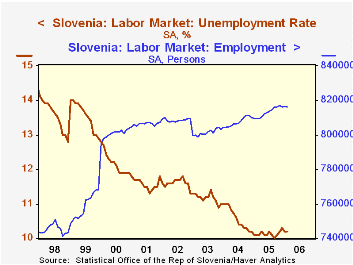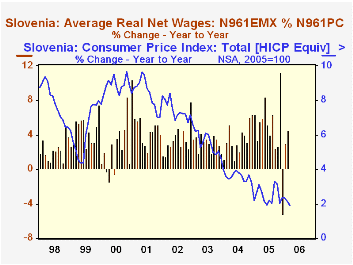 Global| Apr 19 2006
Global| Apr 19 2006Slovenia: Labor Market Hesitation Follows Good Growth in 2005
Summary
The labor market seems to be slowing just a bit in Slovenia, according to the monthly labor force survey reported today by the Statistical Office; after climbing from April 2005 through November, employment has been virtually flat [...]

The labor market seems to be slowing just a bit in Slovenia, according to the monthly labor force survey reported today by the Statistical Office; after climbing from April 2005 through November, employment has been virtually flat since then through February. Even so, at 816,156, it stands 0.8% above a year ago, matching the growth pace for all of 2004, and close to that for the rest of Europe.
Unemployment continues stubbornly just above 10%, with January and February at 10.2%. This is low historically for the country, but as employment has apparently stopped increasing, unemployment has stopped decreasing. It bottomed out at exactly 10.0% in September.
Workers, meantime, appear to be doing "all right". Their average wages, which were published yesterday, were SIT179.7 in February (SIT=Slovenian Tolars), after social security and income tax withholding. This marks a 2.7% real advance from February 2005, allowing for the 2.1% CPI inflation over the period. Real earnings in the rest of Europe were up just 0.4% in 2005, measured by wages and salaries for the EU-25 calculated by Eurostat.
The average wage indicator hints at general gains in the Slovenian economy; GDP per capita real growth (in fixed 1995 prices) was 4.1% last year. According to the CIA World Factbook, Slovenia is the first transition economy to change from borrower to donor status at the World Bank, and its currency, presently pegged to the euro, is due to switch to the euro next year. All is not completely well, though, as the population has been almost completely flat since 1999; there was net out-migration during the break-up of Yugoslavia, then a modest recovery from 1999 to 2002, but almost no change since. And as we note here, the economy may be showing signs of plateauing after a nice run during 2005.
Country-source data on Slovenia are found in Haver's EMERGECW database. Since the country joined the European Union in 2004, data generated by Eurostat are also found in the EUROSTAT database. The CIA's helpful information on the general characteristics of the country are found here.
| Slovenia | Feb 2006 | Jan 2006 | Feb 2005 | 2005 | 2004 | 2003 |
|---|---|---|---|---|---|---|
| Employment (SA, Thous.) | 816.2 | 816.6 | 809.6 | 813.1 | 807.5 | 801.4 |
| % Change (Mo/Mo & Yr/Yr) | -0.0 | 0.0 | (yr/yr) 0.8 | 0.7 | 0.8 | -0.9 |
| Unemployment Rate (SA, %) | 10.2 | 10.2 | 10.1 | 10.1 | 10.6 | 11.2 |
| Average Net Wages (Thous. Tolars) |
179.7 | 179.3 | 171.4 | 177.1 | 168.2 | 159.1 |
| "Real" % Change* (Mo/Mo & Yr/Yr) |
-0.2 | 2.0 | (yr/yr) 2.7 | 2.7 | 2.1 | 1.8 |
Carol Stone, CBE
AuthorMore in Author Profile »Carol Stone, CBE came to Haver Analytics in 2003 following more than 35 years as a financial market economist at major Wall Street financial institutions, most especially Merrill Lynch and Nomura Securities. She had broad experience in analysis and forecasting of flow-of-funds accounts, the federal budget and Federal Reserve operations. At Nomura Securities, among other duties, she developed various indicator forecasting tools and edited a daily global publication produced in London and New York for readers in Tokyo. At Haver Analytics, Carol was a member of the Research Department, aiding database managers with research and documentation efforts, as well as posting commentary on select economic reports. In addition, she conducted Ways-of-the-World, a blog on economic issues for an Episcopal-Church-affiliated website, The Geranium Farm. During her career, Carol served as an officer of the Money Marketeers and the Downtown Economists Club. She had a PhD from NYU's Stern School of Business. She lived in Brooklyn, New York, and had a weekend home on Long Island.





